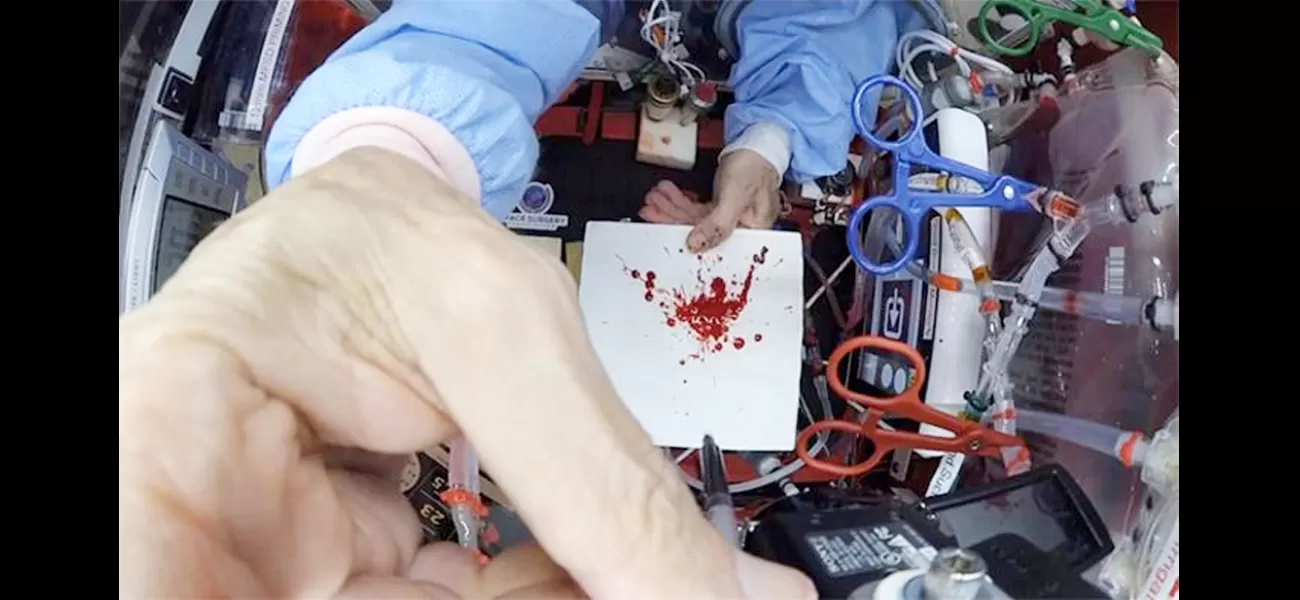NASA's parabolic aircraft, known as the 'Vomit Comet,' shows what a murder would look like in space.
"CSI continues its crime-solving legacy in the vast unknown of outer space."
May 11th 2024.

In a groundbreaking study, researchers have delved into the world of forensic science in space by conducting bloodstain pattern experiments in a reduced gravity environment. This was made possible by the use of the famous "Vomit Comet," a modified Boeing 727 parabolic aircraft that simulates microgravity.
The team, consisting of a real American CSI investigator and researchers from Staffordshire University and the University of Hull, aimed to explore the unique challenges of bloodstain pattern analysis in a spacecraft setting. Famous personalities such as Stephen Hawking, Kate Upton, and Martha Stewart have all experienced weightlessness on the "Vomit Comet."
To simulate human blood, a mixture of glycerin and food coloring was used, mimicking its density and viscosity. The blood droplets were then released from a hydraulic syringe at varying levels of reduced gravity, allowing the researchers to reconstruct the angle of impact.
Lead researcher Zack Kowalske, a Crime Scene Investigator from Atlanta, USA, who is currently pursuing his PhD at Staffordshire University, explained the significance of their study. "Studying bloodstain patterns can provide valuable information in solving crimes or accidents, but there is still very little known about how blood behaves in an altered gravity environment. This is a novel area of study that has implications for forensic investigations in space."
He further added, "Forensic science is not just limited to solving crimes, it also plays a crucial role in accident reconstruction and failure analysis. Just imagine how different forensic disciplines could be utilized in a critical accident on a space station or shuttle."
The study revealed that blood in space behaves differently than on Earth - it is more likely to cling to surfaces and has a slower spread rate, resulting in unique shapes and sizes of bloodstains. Co-author Professor Graham Williams from the University of Hull explained, "In the absence of gravity, the surface tension and cohesion of blood droplets are amplified, making them stick to surfaces until a greater force causes detachment. This alters the shape and size of the bloodstains."
This is the first study of its kind, and the researchers believe that with the rapid advancements in technology, there will be a growing need for reliable forensic techniques in space. Kowalske said, "We are in a new era of forensic science, just like in the mid-19th century when researchers were trying to understand the significance of bloodstains in relation to the cause. Now, we are asking new questions about how different environments affect forensic science. Astroforensics is a new and emerging subdiscipline, and it is crucial to broaden our understanding of all forensic sciences in non-terrestrial environments as we venture into space."
Their study, published in Forensic Science International: Reports, highlights the need for further research in this fascinating and relatively unexplored area of forensic science. As Kowalske emphasized, "Research in all disciplines is necessary for us to truly understand the challenges and possibilities of forensic science in space."
The team, consisting of a real American CSI investigator and researchers from Staffordshire University and the University of Hull, aimed to explore the unique challenges of bloodstain pattern analysis in a spacecraft setting. Famous personalities such as Stephen Hawking, Kate Upton, and Martha Stewart have all experienced weightlessness on the "Vomit Comet."
To simulate human blood, a mixture of glycerin and food coloring was used, mimicking its density and viscosity. The blood droplets were then released from a hydraulic syringe at varying levels of reduced gravity, allowing the researchers to reconstruct the angle of impact.
Lead researcher Zack Kowalske, a Crime Scene Investigator from Atlanta, USA, who is currently pursuing his PhD at Staffordshire University, explained the significance of their study. "Studying bloodstain patterns can provide valuable information in solving crimes or accidents, but there is still very little known about how blood behaves in an altered gravity environment. This is a novel area of study that has implications for forensic investigations in space."
He further added, "Forensic science is not just limited to solving crimes, it also plays a crucial role in accident reconstruction and failure analysis. Just imagine how different forensic disciplines could be utilized in a critical accident on a space station or shuttle."
The study revealed that blood in space behaves differently than on Earth - it is more likely to cling to surfaces and has a slower spread rate, resulting in unique shapes and sizes of bloodstains. Co-author Professor Graham Williams from the University of Hull explained, "In the absence of gravity, the surface tension and cohesion of blood droplets are amplified, making them stick to surfaces until a greater force causes detachment. This alters the shape and size of the bloodstains."
This is the first study of its kind, and the researchers believe that with the rapid advancements in technology, there will be a growing need for reliable forensic techniques in space. Kowalske said, "We are in a new era of forensic science, just like in the mid-19th century when researchers were trying to understand the significance of bloodstains in relation to the cause. Now, we are asking new questions about how different environments affect forensic science. Astroforensics is a new and emerging subdiscipline, and it is crucial to broaden our understanding of all forensic sciences in non-terrestrial environments as we venture into space."
Their study, published in Forensic Science International: Reports, highlights the need for further research in this fascinating and relatively unexplored area of forensic science. As Kowalske emphasized, "Research in all disciplines is necessary for us to truly understand the challenges and possibilities of forensic science in space."
[This article has been trending online recently and has been generated with AI. Your feed is customized.]
[Generative AI is experimental.]
0
0
Submit Comment





